-

The Alphabet
Learn the pronunciation and how to read and write the Arabic alphabet letters
-

Why Learn Arabic
Choosing to learn Arabic will open you up to a whole new world of culture, history and tradition. As the language of the Quran, Arabic has a rich spirituality
-
Join us
To Learn Arabic, it's very easy
-

Tranlation and interpretaion services
Mail me on MyArabicBuddy@gmail.com
-

Importance of Arabic.
To understand Islam and Qura'an you need to study Arabic
Arabic Alphabet
The Arabic alphabet ( الحُرُوف العَرَبِيَّة ) is the Arabic script as it is codified for writing the Arabic language. It is written from right to left in a cursive style and includes 28 letters.
The basic Arabic alphabet contains 28 letters. Adaptations of the Arabic script for other languages added and removed some letters, as for Kurdish, Persian, Ottoman Turkish, Sindhi, Urdu, Malay, Pashto, Arwi and Malayalam (Arabi Malayalam), all of which have additional letters as shown below. There are no distinct upper and lower caseletter forms.
Many letters look similar but are distinguished from one another by dots (i‘jām) above or below their central part (rasm). These dots are an integral part of a letter, since they distinguish between letters that represent different sounds. For example, the Arabic letters transliterated as b and t have the same basic shape, but b has one dot below, ب, and t has two dots above, ت.
Both printed and written Arabic are cursive, with most of the letters within a word directly connected to the adjacent letters.
| ي | و | ه | ن | م | ل | ك | ق | ف | غ | ع | ظ | ط | ض | ص | ش | س | ز | ر | ذ | د | خ | ح | ج | ث | ت | ب | ا |
| y | w | h | n | m | l | k | q | f | gh | ‘ | ẓ | ṭ | ḍ | ṣ | sh | s | z | r | dh | d | kh | ḥ | j | th | t | b | ā |
Alphabet sounds
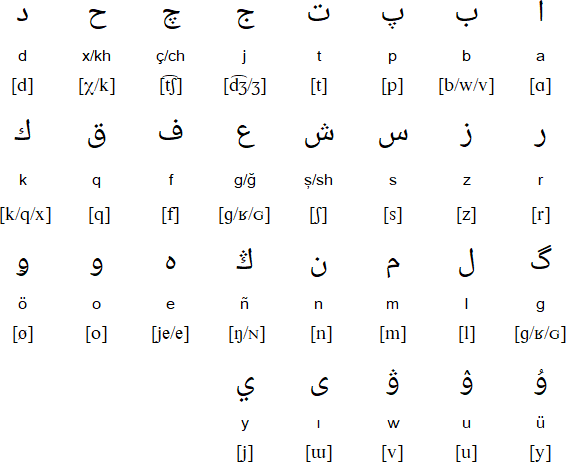
Alphabet letter names

Alphabet with examples
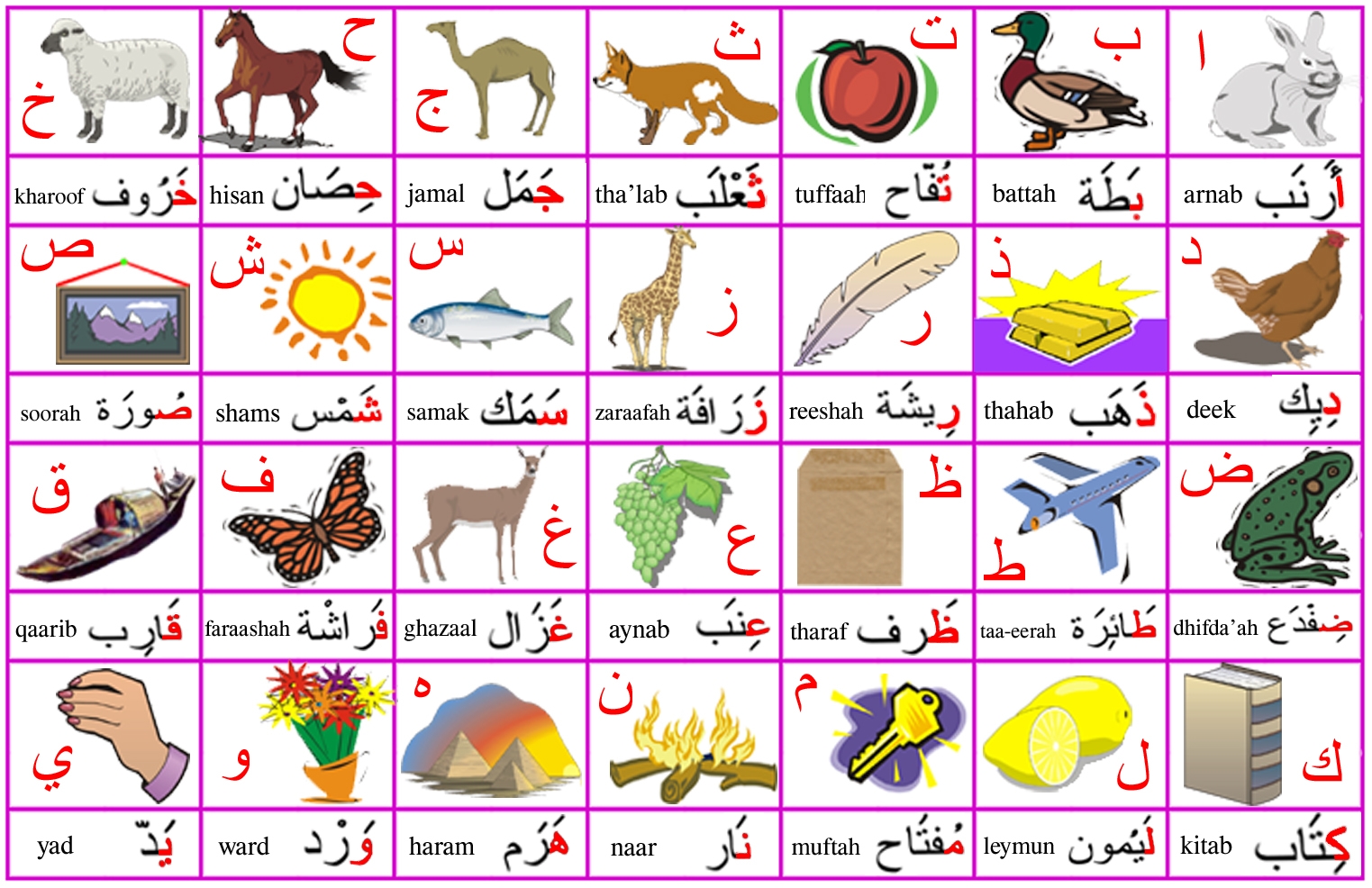
Memorizing the alphabet helps you in reading Arabic and writing
Arabic Alphabet
Let's start with the Arabic alphabet, as this is the basis for the other lessons. Here are some basic characteristics of the Arabic writing system:
- The Arabic alphabet contains 28 letters.
- Arabic is written from right to left.
- In Arabic short vowels are generally not written.
- Arabic letters change their shape according to their position in a word.
Let's go through these points in more detail.
The Arabic alphabet contains 28 letters.
This means that the Arabic alphabet contains only two more letters than the English alphabet (26 letters). However, unlike English, the Arabic letters are always pronounced in the same way. In English the letter "c" is sometimes pronounced like an "s" (ceasar) and sometimes like a "k" (cucumber). Or, to take another example, "gh" is sometimes pronounced "f" (enough) and sometimes pronounced "g" (ghost). In Arabic, the letters always retain their sound.
Arabic is written from right to left.
English, of course, is written from left to right like this.
from left to right
-> -> -> -> ->
-> -> -> -> ->
Arabic, on the other hand is written from right to left:
tfel ot thgir morf
<- <- <- <- <-
Sure, this takes some getting used to, but is not that hard with enough practice.
In Arabic short vowels are generally not written.
There are three short vowels in Arabic: a short "u" (as in "look"), a short "a" (as in "can") and a short "i" (as in "with"). Usually these short vowels are simply omitted in writing. Long vowels (such as the "ee" in "tree") are written. A sentence such as:
"The book in the tree is very ugly and rotten."
becomes
"Th bk 'n th tree 's vr 'gl 'nd rttn."
This omission of short vowels can be very difficult in the beginning, because it's difficult to guess which short vowels exactly are missing. As you learn more about Arabic grammar you will be able to "guess" the missing short vowels and pronounce unknown words.
Arabic letters change their shape according to their position in a word.
The Arabic script is essentially a cursive script, much like handwritten English. I.e. almost all the letters within a word are connected to each other. This necessitates certain changes in their shapes. If you write an English word cursively, then you will also make certain changes to the letters. For example, the letter "s" will be connected to the letter on the left with a diagonal stroke if that preceding letter is e.g. an "n".
However, in Arabic these changes can be quite drastic. Take a look at the following table that summarizes the letters in the Arabic alphabet and their shapes according to whether they are:
1) on their own (isolated),
2) at the start of a word
3) in the middle of a word
or
4) at the end of a word.
1) on their own (isolated),
2) at the start of a word
3) in the middle of a word
or
4) at the end of a word.
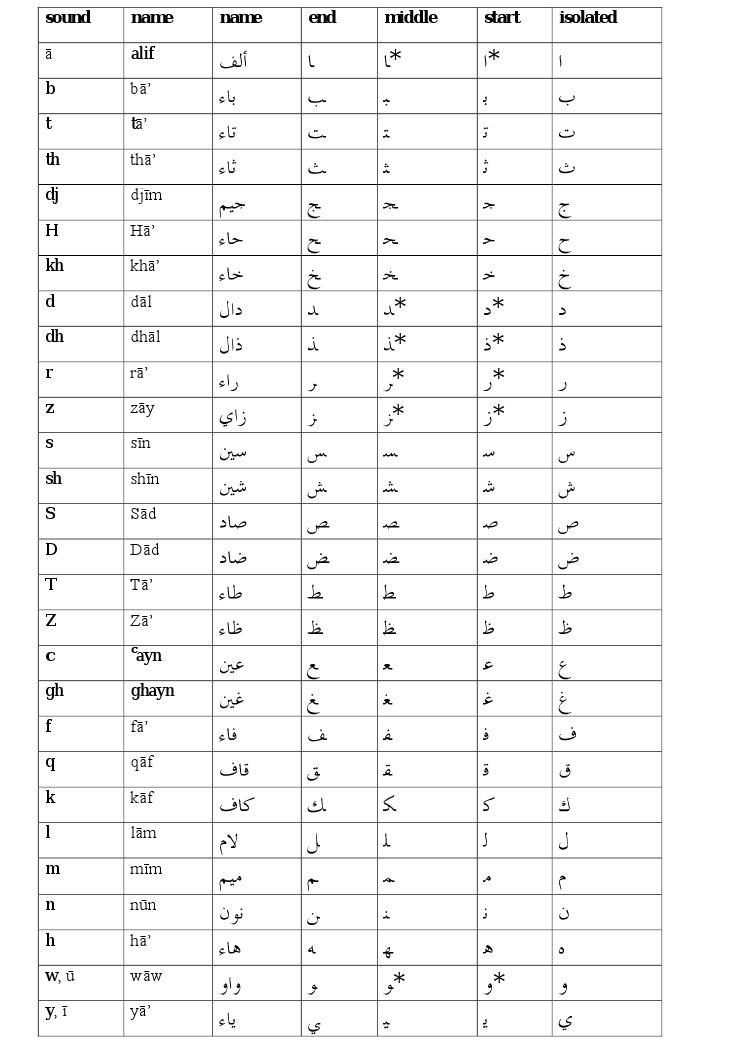
* The six letters marked with an asterisk (*) cannot be connected to the left.
You should write the letters a few times each to get a feeling for them.
Pronouncing the Arabic sounds
Now that you've had a first glance at the Arabic alphabet, you're ready to learn the pronunciation of the letters.
For simplicity let's divide the letters into three groups, according to their difficulty.
Easy
In this group are all the letters that are more or less exactly pronounced as their English counterparts.
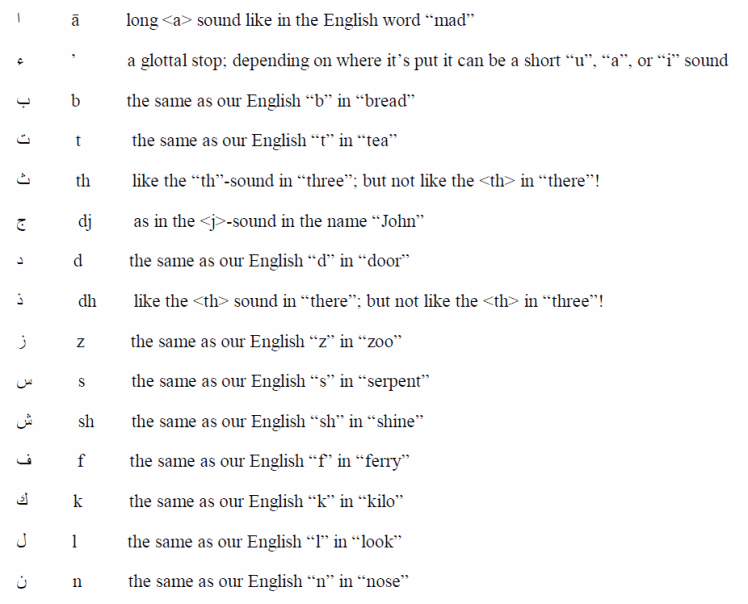

Medium
These letters are still somewhat similar to English sounds, but already more difficult to pronounce.
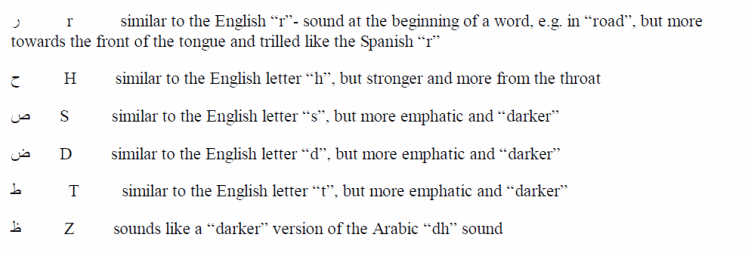
Difficult
These Arabic letters can prove tough to pronounce for beginners. Keep at it, though, and listen to recordings of native speakers. Eventually, your throat will hurt and you'll get it right!

Putting letters together to form words
Now that you know how to write and pronounce individual Arabic letters, let's take a look at putting them together to form words.
salaam means "peace" in Arabic. To write the word start from the right and connect all the letters:
Let's take a look at another word: mumtaaz - which means "excellent" in Arabic.
End of lesson.
English-Arabic Familiar
If English is your primary language, part of grasping a new lougha (loo-rah; language) is creating connections between the kalimaat (kah-lee-maht; words) of the lougha, in this case Arabic, and English. You may be surprised to hear that quite a few English words trace their origins to Arabic. For example, did you know that “magazine,” “candy,” and “coffee” are actually Arabic words?
As you can see from the table, Arabic has had a major influence on the English language. Some English words such as “admiral” and “arsenal” have an indirect Arabic origin, whereas others, such as “coffee” and “cotton,” are exact matches! The influence runs the other way, too, especially when it comes to relatively contemporary terms. For example, the word tilifizyuun (tee-lee-fee-zee-yoon; television) comes straight from the word “television.” As is often the case with languages, Arabic and English tend to influence each other, and that’s what makes studying them so much fun!
Below lists some familiar
English words with Arabic origins.
Arabic
Origins of English Words
|
||
English
|
Arabic Origin
|
Arabic Meaning
|
admiral
|
amir al-baHr
|
Ruler of the Sea
|
alcohol
|
al-kuHul
|
a mixture of powdered
antimony
|
alcove
|
al-qubba
|
a dome or arch
|
algebra
|
al-jabr
|
to reduce or consolidate
|
almanac
|
al-manakh
|
a calendar
|
arsenal
|
daar As-SinaaH
|
house of manufacture
|
azure
|
al-azward
|
lapis lazuli
|
candy
|
qand
|
cane sugar
|
coffee
|
qahwa
|
coffee
|
cotton
|
quTun
|
cotton
|
elixir
|
al-iksiir
|
philosopher’s stone
|
gazelle
|
ghazaal
|
gazelle
|
hazard
|
az-zahr
|
dice
|
magazine
|
al-makhzan
|
a storehouse; a place of
storage
|
mattress
|
matraH
|
a place where things are thrown
|
ream
|
rizma
|
a bundle
|
saffron
|
za’fran
|
saffron
|
Sahara
|
SaHraa’
|
desert
|
satin
|
zaytuun
|
Arabic name for a Chinese city
|
sherbet
|
sharaba
|
to drink
|
|||
sofa
|
Sofaa
|
||||
sugar
|
sukkar
|
sugar
|
|||
zero
|
Sifr
|
zero
|
|||


























